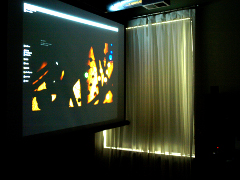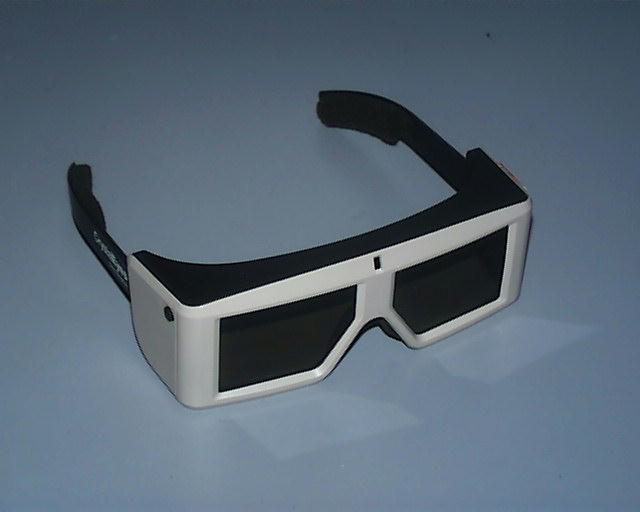NOTE: I have switched over to the iZ3D monitor, and have not looked back. I will focus my attention moving forward on that hardware solution. This guide is reflective of my projector days using the NVIDIA stereoscopic 3D drivers that are no longer supported with non-NVIDIA branded shutter glasses.
[*] Introduction
[*] Getting Started
[*] Best Settings
[*] Recommended Games
[*] Conclusion
[/url]
Introduction

Video gaming, in all its lusty bravado, is still so two dimensional.
Well, it was for me, until one fateful day circa 1999. While killing time, I happened across a review evangelizing the merits of an esoteric new phenomenon - Stereoscopy had come to the world of PC gaming! Being a technology/gaming loafist, I decided I must have this innovation, and spent weeks researching the history and technology behind this wizardry. The basic principals at work had been around for a long while, and while I won’t get into the guts of the way it works or such, you can look at mtbs3d.com for an excellent resource behind the science. I just want to document my setup and help any burgeoning 3D bound souls.
Back in the day there was some proprietary hardware needed to attain the shutter glasses solution. There was a time you would buy a specific graphics card that would ship with a pair of glasses that, when connected to a computer running the drivers packed in, would shutter in sync with your monitor’s refresh rate to alternate the image each eye received, thereby giving you a sense of depth.

Things changed a few years later when NVIDIA released its own free S-3D driver that would work in tandem with its GeForce driver. All was well for a spell, until last year when they stopped providing a free global S-3D solution. The technology stalled for the shutter glasses users, and the only way to use 3D gaming (with this solution) is to track down some old drivers and do a bit of registry magic to get everything humming.
[/url]
Getting Started
Here is my current setup used to run my stereo 3d gaming rig:
Hardware:
- Graphics card: Dual 7800’s running in SLI
- Graphic drivers: 162.50 NVIDIA GeForce Drivers (AKA Forceware)
- Stereoscopic drivers: 162.50 stereo drivers
- Projector: Sharp XR10X-L (refurbished from pcrush.com)
- Standard Shutter Glasses
Default stereo 3D settings:
- 35% separation (my default)
- 70" display (projector throws a 100” vertical)
- 1024 X 768 resolution with 75 hz refresh rate as default
You need to have very specific hardware in order to run games using my chosen setup. Again, NVIDIA stopped officially supporting their 3D drivers (for this setup), so many modern day features are absent.
First, install the two drivers mentioned above. One is the Nvidia graphics card drivers, while the other is the stereo 3D driver. Since these are old drivers, most modern games will run without the new post processing and lighting effects. In stereo vision this is much less of a concern because depth and pop-out is the main attraction. Still, it would be nice to actually play the games as they were meant to be played (NOTE: current iZ3D drivers do not face this challenge).
NVIDIA hasn’t abandoned the concept completely; they want to profit, and have set up a partnership with another company to release proprietary drivers with their own proprietary glasses. For more information, visit mtbs3d.com.
Once you have the NVIDIA drivers installed, you will need to modify the registry. For some reason, the NVIDIA control panel obscures the 3D options out of the box. Luckily, the options are still there and you can enable them.
Run regedit from the start menu "Run" command. Here we need to drill down to this key and make sure the values are set to the appropriate dword listed:
[HKEY_LOCAL_MACHINESOFTWARENVIDIA CorporationGlobalNvCplApiPolicies]
"ContextUIPolicy"=dword:00000001
"CplGroupUIPolicy"=dword:00000001
Make sure these keys are present with the values specified below. This will force the Nvidia control panel to display our stereo options.
[/url]
Best Settings
Now, we can begin to setup the experience. I prefer to modify these settings like so:
Digital Vibrance: HIGH
The glasses will inherently dull the color/brightness of the display due to the shuttering and plastic. The NVIDIA cards have this neat overdriven saturation setting which will help greatly. Without the glasses, the colors will be absurdly saturated, so you may want to only change this while playing 3D games.
Monitor Size
Make sure to set this to the appropriate size, as this plays into the separation. For me, I chose the maximum 71" because the vertical diagonal of the projection is impressive.
Enabled by Hot Key
I set this to Alt-R, as I use the Nostromo Speedpad for gaming and I don’t want to have to reach for the keyboard in the dark.
Cross-Hair
I disable for all games. I have never had good luck with this, so I turn it off. When it works correctly, it can be quite effective, but I always end up with a crosshair rendered at the wrong depth, confusing my brain.
Stereo Separation
The default amount that you want the two images to be rendered apart. This increases depth, but can be jarring if the value is set too high. Your eyes may need an adjustment period. I usually leave this around 20%. The nice thing is you can dynamically adjust this along with convergence while playing your game, so you don’t need to make a lasting commitment at this point.
Using the projector, I run at 1024 x 768 for almost all of the games. The projector can handle input resolutions up to 1280 x 1024, but it is not native and the projector actually down samples the larger resolution to compensate. Also, the refresh rate takes a hit at this resolution, and can often dip below 75hz. Low refresh rates cause strobe in some games, so I usually stay at 1024 x 768.
An important benefit of S-3D gaming is that resolution and graphics can appear much better due to the true sense of weight and depth. It’s great, because it makes older games playable all over again. An old game that is well rendered in 3D can look better than a new one in 2D.
That’s it. You are now configured to experience the most amazing and atmospheric way to currently game at home. Now it is just a matter of hooking up the projector, dimming the lights, and getting lost on holiday.
[/url]
Recommended Games
So now that you have it all running, which games should you check out? This is a small sample to get you started:
Half Life 2 (all episodes)
Run this with color correction disabled. This game transports you to another world. All source engine games look fantastic in 3D. The white forest/caves in episode 2 (with headphones as well) is probably the most immersive game experience I have ever had. There is no way to describe how cool the spelunking of this level feels. The only drawback is the colors at times can be a bit off.
Thief 3
With the introduction text hanging in space, your mouth will hang open. Stunning. In game, the depth is surreal: shadows are welcoming, and flames dance around you. The Shalebridge level (widely agreed as one of the single most terrifying video game experiences) is nearly unplayable in 3D due to the paranoia. Truly amazing.
Doom 3/Quake 4
Another game engine that is obviously coded well, has everything in its right place. Amazing depth with monsters that seem to be in your room. I constantly walk up to windows, stained with blood and grime, just to stare into an adjacent room and observe. You can lose yourself in the virtual world...until a 70” tall cacodemon hurls a fireball right at your head!
Alice
Scale is stunning, the levels a madman’s nightmare. Nice convergence on projectiles. A distant battle between Alice and a card flinging specter is a sight to behold.
Far Cry
Really does look like a tropic paradise. Trees seem to pop out into the room as you sneak through the brush. Game play is a bit dated, however.
Prey
The game to play if you are a sci-fi fan. Gravity inverts, mammoth space ships, and alien technology all look stunning in 3d.
Oblivion
Competes with Half Life 2 for my most impressive experience. Really, I can’t imagine anyone playing this in 2D. There is no way to convey the experience of standing in a field of red and pink flowers blowing gently in the wind, staring out at the expanse of mountains and castles with majestic music playing in the background. I sometimes just wander town to town to experience the world in 3D, the same way I would on vacation.
[/url]
Conclusion
There is so much more out there to experience. Believe me, any passionate gamer has not truly experienced a virtual world until they have actually squinted into the distance and felt that deep awe, or gazed longingly up at descending virtual snowflakes in true 3D.
It is almost pointless writing about the difference stereo 3d makes in gaming, as words will always fail to convey the real experience. With the cooperation of media industries and the proliferation of new hardware solutions, it’s only a matter of time before S-3D becomes more mainstream. While the solution I presented is a bit out of time, there are fantastic new solutions currently available and more on the way. I look forward to writing proper reviews of major new game releases seen through the eyes of the iZ3D monitor.
Share your thoughts on this guide in the MTBS forums[/b]!
Read full article...
